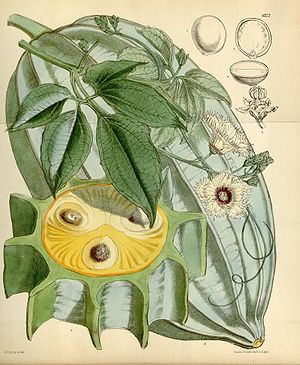Telfairia occidentalis
| Telfairia occidentalis | ||||||||||||
|---|---|---|---|---|---|---|---|---|---|---|---|---|

Telfairia occidentalis , illustration |
||||||||||||
| Systematics | ||||||||||||
|
||||||||||||
| Scientific name | ||||||||||||
| Telfairia occidentalis | ||||||||||||
| Hook.f. |
Telfairia occidentalis is a crop from tropical West Africa and is a species of the cucurbit family (Cucurbitaceae). Above all, the seeds but also the young sprouts and leaves are used as vegetables.
features
The species forms up to 15-20 meters long, persistent and mostly dioecious, diocesan lianas with two-part tendrils . Monoecular plants rarely appear .
The helically arranged and assembled hand- or foot-shaped leaves are long-stalked, with up to 5 leaflets . The petiole is up to 10-15 centimeters long. The stalked and distantly serrated, pointed or pointed to tailed leaflets are up to 15-19 centimeters long. The veins impressed on the upper side are threefold. The stipules are missing.
There are small ones (Probrakteen, Probracts) available.
The male flowers are in axillary and long-stemmed, short racemes , with a single long-stalked flower at the base of the inflorescence style that blooms first, the larger female flowers appear individually. The five-fold and stalked, bell-shaped, unisexual flowers with a double flower envelope are whitish with a purple-reddish center, throat. The triangular calyx tips are small and sawn on the edge, the obovate, fine-haired and veined petals are fringed on the edge. The male flowers have 5 or 3 unequal, short stamens , with 5 4 are fused in pairs, if these 4 are completely fused then only 3 stamens are left. The ovary of the female flowers is three-chambered and subordinate, in a small flower cup , with a short stylus with a large, lobed stigma .
The very large, multi-seeded fruit, a berry (armored berry, false fruit ) is greenish and ovate to ellipsoidal and is 40–100 centimeters long and weighs up to 6 kg (up to 50 kg). When it is ripe, it is "frosted" with a white wax coating. It has ten broad ribs, which is why it also bears the common English name Fluted pumpkin (ripple pumpkin). The mostly many (6 to 200) seeds are dark to light brown, egg-shaped to rounded, flattened, smooth and up to 4–5 centimeters in size. A reticulate, light brown and porous endocarp layer envelops the seeds. The seeds contain up to 20-25% protein and 40-50% fat and they taste like almonds .
The seeds are sensitive to dehydration. One seed produces several shoots, so that up to four seedlings can be obtained from one seed.
The number of chromosomes is 2n = 22 or 24.
Distribution and locations
The species is native to tropical West Africa and occurs in the Congo Basin east to Uganda . However, no wild occurrences are known. It is cultivated particularly in Nigeria , Ghana, Benin , Cameroon and Sierra Leone , but also in other countries in the region. It is also grown in Florida as a summer vegetable .
Use and cultivation
The lianas are tied to supports or grow on the ground. Although the plant is perennial, it is grown as an annual fruit. In Nigeria, phosphorus fertilization is particularly important for increasing yields. They grow best during the rainy season from April to October, with watering the growing season can be extended into the dry season.
If the plants are grown for the vegetable use of the vegetative parts, the young fruits are removed from the plants. Female plants are more productive. Frequent harvesting of the young shoots increases branching; in the five-month harvest season, up to 15 times can be harvested. When producing seeds, the fruits are harvested shortly before they are fully ripe.
Propagation takes place via seeds or cuttings . The first harvest takes place around three months after sowing.
The seeds are cooked like beans or processed into flour, young seeds are also fermented. An edible oil can also be obtained from them.
The leaves are used as soup herbs, young shoots as vegetables. Stem fibers are processed into sponges.
In Nigeria, leaves and fruits have developed into an important regional commodity that is traded over distances of up to 300 kilometers. The plant is now also grown here in the savannah.
literature
- Jules Janick, Robert E. Paull: The Encyclopedia of Fruit and Nuts. CABI, 2008, ISBN 978-0-85199-638-7 , p. 310 ff.
- RW Robinson, DS Decker-Walters: Cucurbits. CABI, Wallingford 1997, ISBN 0-85199-133-5 , pp. 110-111.
- SA Ajayi, M. E Dulloo, RS Vodouhe, P. Berjak, JI Kioko: Conservation status of Telfairia spp. in sub-Saharan Africa. In: R. Vodouhe, K. Atta-Krah, GE Achigan-Dako, O. Eyog-Matig, H. Avohou (eds.): Plant Genetic Resources and Food Security in West and Central Africa. Biodiversity International 2007, ISBN 978-92-9043-750-5 , online at researchgate.net.
- James A. Duke: Handbook of Nuts. CRC Press, 1989, 2001, ISBN 0-8493-3637-6 , pp. 276 f.
Web links
- Telfairia occidentalis at Useful Tropical Plants.
- Telfairia occidentalis at PROTA.
- Telfairia occidentalis . In: S. Dressler, M. Schmidt, G. Zizka (Eds.): African plants - A Photo Guide. Senckenberg, Frankfurt / Main 2014.
Individual evidence
- ↑ Telfairia occidentalis at Tropicos.org. In: IPCN Chromosome Reports . Missouri Botanical Garden, St. Louis
- ^ A b S. A. Ajayi, P. Berjak, JI Kioko, ME Dulloo, RS Vodouhe: Progress on the conservation of fluted pumpkin (Telfairia occidentalis) germplasm. In: R. Vodouhe, K. Atta-Krah, GE Achigan-Dako, O. Eyog-Matig, H. Avohou (eds.): Plant Genetic Resources and Food Security in West and Central Africa. Biodiversity International 2007, ISBN 978-92-9043-750-5 (online PDF) .
